by tmoffett | Mar 19, 2012 | Black and White, Landscape, Photographic Philosophy, Photographic Technique

Grape Leaves
One of the most frequently asked questions by students in my classroom while working on photographs in Photoshop is, “What should I do to this image?” Nearly always my reply is the same. “What did you see and feel when you photographed it?” This concept of visualizing the end result before pressing the shutter button on the camera is becoming a lost art, yet is so important to achieving consistent, meaningful and powerful results.
I began to understand the idea of previsualization while studying Ansel Adams zone system under the tutelage of Craig Law at Utah State University. When making exposures using the zone system, a photographer must first know what he/she wants because the exposure settings (aperture and shutter speed) and film development process is determined by what the finished print is to look like. The whole process is very calculated. One must slow down and think about the image that is about to be created. Some may claim that this attention paid to the technical details takes away from the spontaneous art of photography. I differ with this way of thinking. Slowing down, really looking and taking in a scene allows me the opportunity to feel my surroundings. I am able to focus on my emotions. What is it that caught my attention in the first place? Why do I feel I need to make a photograph? What do I really see? What emotion do I want to elicit in the viewer of the image I am about to make? These are just some of the questions that I ask myself while setting up to photograph a particular scene. Only after I have taken the time to experience the scene that I am about to photograph am I able to determine how best to replicate those emotions in a photograph. Once those decisions are made, there is no question as to how to process the image upon returning home. I have already experienced it!
Even though I now use advanced digital equipment instead of film for my photography, the principle of previsualization learned years ago is still prevalent in my methods of working. When out photographing, I first pay close attention to my emotional response to the scene in front of me. If I have no emotional response, the photograph will have no power. This determines whether or not I even take the camera out of the bag. After deciding that a scene is indeed worth photographing and what emotional response I want to evoke, I can then successfully determine the correct exposure settings, lens selection, white balance, ISO, etc. are necessary to convey my message. At the same time, processing and editing methods are determined as well.
All of this takes time and effort. By slowing down and thinking, even meditating while photographing, you too can learn to create more powerful images while actually making fewer exposures.
by tmoffett | Mar 14, 2012 | Color, Landscape, Photographic Philosophy
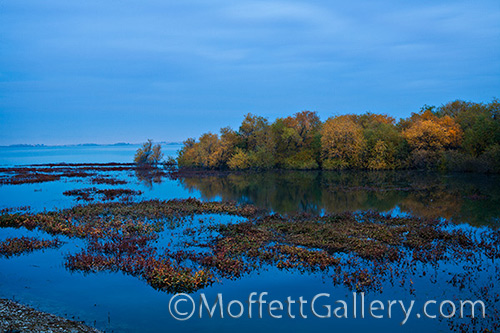
Midnight Blues, an image from Silent Solitude
My silence has been long enough. I have decided to return to the world of blogging after a longer than expected absence. It seemed as though my life was beginning to revolve around my daily blogging. I was losing touch with the things of most importance. My family was suffering. My photography was suffering. Most importantly, I was suffering. Trying to keep up with a daily blog entry that had content that would benefit my followers was too much, so I am returning with a different format. I will be writing content on a regular, but less frequent basis. Two to three times a week new content will be added in a way that, hopefully, you will find beneficial, interesting and fun to read. I will continue to add new photographs with each post as well.
During my absence I have been busy. I just finished my first book, Silent Solitude. I have been photographing at our local lake, Lake Lowell, over the past several years, and have compiled my favorite images as well some of my ramblings about my photographic and artistic philosophies into a coffee table book. The book contains more than 60 images made during all seasons of the year and shows the quiet side of the lake. Even though there is much recreational activity at the lake, a quiet, serene setting can be found. I work in the very early and late hours of the day, many times after everyone else, including other photographers have packed up and gone home. I find inspiration while working on a moonlit summer evening or in the early hours before the sun rises. The colors are rich and the water is calm. While walking the shoreline I can meditate, uninterupted by the chaotic sounds that fill the daytime hours. It is my way of maintaining sanity in an insanely busy world.
The photographs in this volume are an extension of my innermost feelings. They are more than just pictures, they are me. They are what and how I see, how I visualize the environment in which I live and work and play. By channeling my feelings and my emotions into my photographs, I attempt to allow the viewer to experience a bit of what I feel when I am making the image. When successful, the images become more than photographs, they become art.
To purchase Silent Solitude, click on the button in the sidebar. A full preview of the book can be found at blurb.com.
by tmoffett | Feb 3, 2011 | Color, Landscape, Ramblings
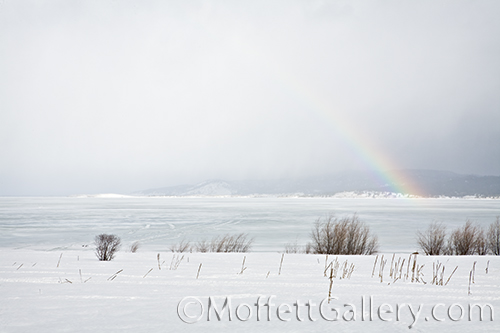
Rainbow in the snow
A week and a half ago, Christeena and I spent the weekend in Cascade and McCall just relaxing and enjoying life. No pressing plans, just regrouping and getting ready for the next wave of action at the Moffett house. It proved to be a much needed break. While in Cascade, we drove, or should I say skated around the lake. The roads were iced over and even with my new studded snow tires we did more sliding than driving! I enjoyed the drive while Christeena became a nervous wreck, as she thought that every time we slid a little we were going to end up stuck in a snowbank or in the lake. I probably would have been the same had I been in the passenger seat. I’m sure it didn’t help matters when I was paying attention to the scenery, looking for photo opportunities more than watching the road!
As we rounded a bend and had a great view of the frozen lake, the snow was blowing and then the sun attempted to peak through the clouds, and as it did this rainbow appeared. I don’t ever recall seeing a rainbow in the middle of a snowstorm before. It was quite the sight. I got out in the storm to photograph this interesting phenomenon. The above image is the result.
by tmoffett | Feb 1, 2011 | Color, Landscape, Photographic Philosophy
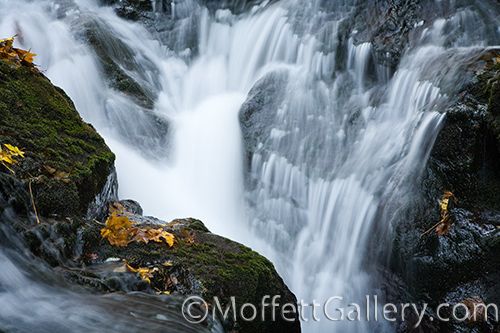
Fall on Sweet Creek
A short hike up Sweet Creek in the Fall is a wonderful sight. Even with the lower water levels, the water cascading down the mountain is incredible. I walked about a one mile stretch and lost count of how many little waterfalls I found. If you ever get the chance, this is definitely one hike you must take. I have made this same trek in the late Spring, and oh, how different it is. Water levels high and running so fast that it is nearly impossible to photograph well. It is just a mass of whitewater from top to bottom. In the Fall I was able to get right down to the waters edge and really explore. I like to photograph from within the image, using wide angle lenses instead of from a distance. When I can really feel the image I am better able to photograph it with emotion. It is not just about framing up a pretty picture, for me it is about experiencing the scene and then reproducing what I feel. Sometimes it is a small detail, others the grand vista. But always it includes my feelings.
by tmoffett | Jan 26, 2011 | Color, Landscape, Photographic Philosophy
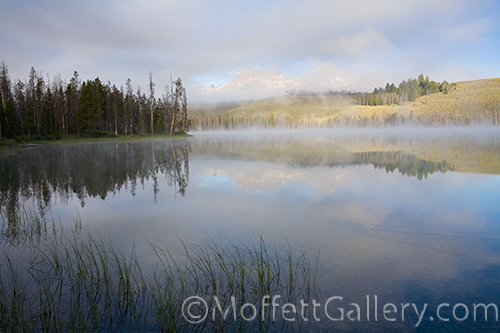
Reflections, Little Redfish Lake
What is style in photography? Is it important to have a style? How do you develop a style?
These are questions that I am frequently asked when teaching and mentoring, so I thought it would be a good topic to discuss here. Style is the unique characteristics of an artists work that differentiates them from other artists. It is very important to have your own style in order to succeed as an artist. Style is what makes you identifiable. Without it, why would anyone want to own one of your photographs? That identifiable style is what will make your images valuable.
I have found that consciously developing a style is difficult. A style will develop on its own as you learn to shoot from the heart. You can practice technique, and, as you do you will begin to find your own style. You will be drawn to certain subject mater or certain lighting conditions. The more you photograph the more defined a style will become. While studying other photographers images and identifying with others work that you enjoy will assist you in identifying your own style, I don’t believe that style development can be pushed. It will just happen as you study and practice. The more you photograph the faster it will develop.
I remember the first time I realized that I had a recognizable style. I had been working tirelessly on a set of images to be displayed in a gallery early on in my career. After delivering the images to the gallery and getting them hung I stepped back to look at the work as a whole. I was taken aback as I could see similarities that tied the individual images together into one work. I could see myself in the photographs in a way I never before had. It was inspiring to see. I had seen it in other artists work, but never before in my own. Since that day years ago, I have noticed my style evolve and become more refined. It continues to change in a way that defines who I am as an artist. My life, my thoughts, by beliefs. My style is who I am.
by tmoffett | Jan 24, 2011 | Color, Composition, Landscape, Photo tips
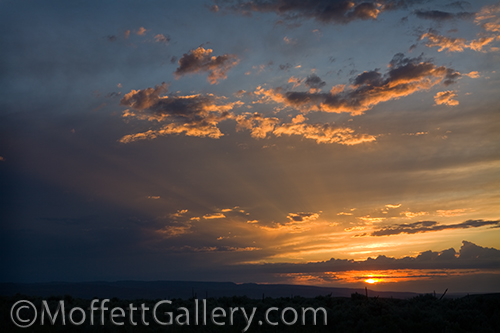
Sunset, Cassia County, Idaho
Sunsets are wonderful. Never the same, they provide so much opportunity to explore color and light. Some are subtle, filling the sky with pastels while others vibrant and deep. Nearly always, though, you will find at least some patches of blue that complement the reds and oranges that fill the sky, adding depth to an already beautiful scene.
While it seems that such incredible scenes are hard to go wrong with in photography, taking some time to carefully compose and think about the scene will greatly enhance your ability to capture it most impressively. Here are a few tips to photographing the sunset.
1. Use a tripod! This is a must for nearly any landscape photography. I use small apertures and low ISO settings to maximize depth of field and color saturation, and the result means a slow shutter speed. Hand-holding will ensure motion blur which is normally completely unacceptable.
2. Compose carefully. Using a tripod helps me to slow down and make sure that everything is near perfect. Level the horizon. Can you use the rule of thirds or is a symmetrical composition better? Check and recheck and then shoot.
3. Shoot a series of images as the sun sets. You might think you have the best image, break down and and move on only to realize that the color gets even better later. I love photographing after sunset. Often my best image is 10-20 minutes after the sun has completely disappeared over the horizon.
4. Bracket the exposure. Exposure is critical with sunsets. Over-expose and you lose saturation, under-expose and you get noise. You really need a perfect exposure in order to get a high quality print.








Recent Comments